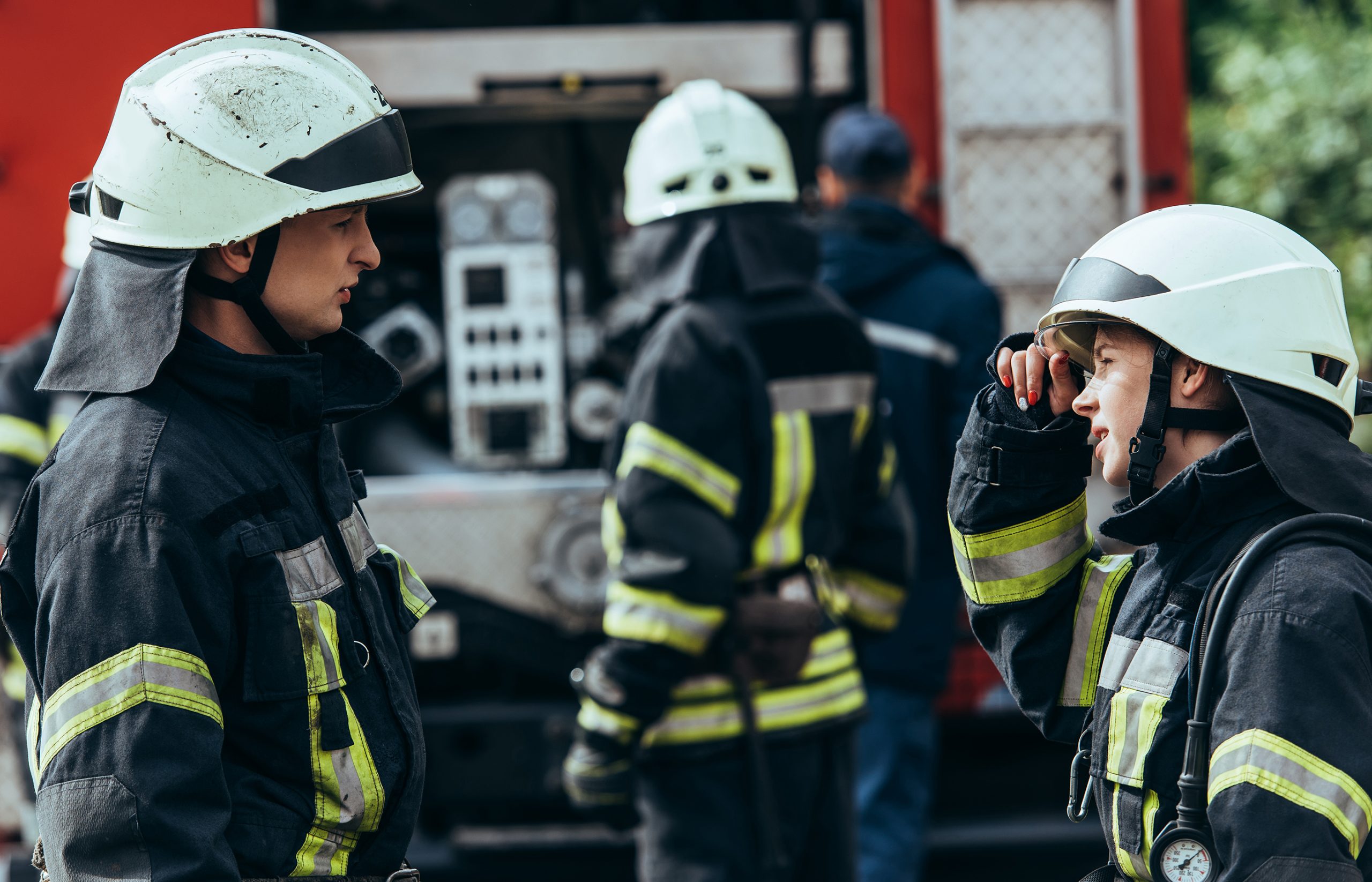Lung Cancer Risk Among Firefighters
Firefighters are at higher risk for harmful exposure to air pollutants like asbestos. Learn more about the risks associated with this profession.

Firefighters and Lung Cancer
Firefighters are the country’s leading providers of emergency medical services and have some of the most hazardous and sensitive jobs in the nation. Usually, the first team to appear at the scene of an emergency, firefighting is a dangerous profession that carries multiple life-threatening risks. Not only is there a daily possibility for injury or death, but an eventual risk that comes from occupational exposure to air toxins that erupt from burning structures (asbestos, carbon monoxide, radon, smog). Some diseases like lung cancer, mesothelioma, and asbestosis have long latency periods and can take decades to develop.
Risks From Harmful Air Pollutants
When building structures go up in flames, the area is flushed with harmful air pollutants (HAPs) and chemicals that are released into the air. Firefighters and lung cancer can occur when one comes into contact with the following toxins:
Asbestos – Burning Buildings and Exposure
A fire-resistant mineral that was used heavily in insulation materials found in buildings and tools. If the structure is on fire and contains asbestos, the mineral becomes friable, which means it’s in a powdered or crumbled state. When friable, asbestos fibers can be released into the air and easily inhaled. Once ingested, the tiny fibers may lodge themselves in or around the lungs, throat, abdomen, and other nearby regions. Symptoms of an asbestos-related illness include chronic coughing and sore throat that doesn’t go away.
Carbon Monoxide – Harmful When Inhaled
A clear gas with no detectable smell that forms when certain carbon-containing compounds (wood, coal, propane) undergo oxidation. Carbon monoxide is harmful to humans in large quantities and is known to seep out of furnaces, water heaters, stoves, fireplaces, chimneys, or space heaters. Some symptoms of carbon monoxide poisoning include flu-like symptoms, headaches, and dizziness.
Lead and Other Heavy Metals
Smoke particulates contain multiple heavy metals that are harmful to human health during combustion when firefighters are exposed. The most common found in building structures include lead, arsenic, cobalt, chromium, mercury, and phosphorus. These metals are naturally occurring, can be found in various environments in the earth, and have been used in the production of building materials.
Radon – Radioactive Exposure Risk
Radon is a radioactive gas that forms from the decomposition of radioactive materials. These materials can be found naturally in underground soil and rock deposits and consist of one or a combination of radium, uranium, and thorium. Once the materials are broken down, the gas rises up from the earth and into the environment. Harmful levels of exposure to radon may eventually cause breathing problems and a recurring cough.
Smog and Smoke – Air Pollutants
When the air contains smog, this means the ozone is contaminated with specific pollutants that can harm human health. The ozone is an odorless, colorless gas made of oxygen that can be found naturally in the Earth’s upper and lower atmosphere. Generally, the upper atmosphere has good ozone, where there’s a protective layer that keeps humans from toxins. The ground-level ozone is more commonly plagued with smog, as it’s frequently impacted by heat or sunlight-reactant pollutants that leak from industrial buildings and structures.
Extensive exposure to smog can irritate and eventually damage the respiratory system and reduce lung function. This may cause hoarseness or pain in the throat, chronic cough, or wheezing.
Common Occupational Lung Diseases Among Firefighters
Occupational exposure to hazardous air pollutants can eventually cause diseases and illnesses after an extended period. Smoke from fires generally contains particulates and gases that irritate the lungs and respiratory areas when released from the combustion of synthetic (plastic) and natural products (wood). Common diseases outside of lung cancer firefighters consist of:
Asbestosis
Also known as pneumoconiosis, asbestosis usually forms in the lungs. When asbestos fibers are ingested, they can get lodged in and around the lungs eventually scratching and damaging tissue in nearby regions, forming asbestosis. This illness can cause symptoms like shortness of breath, dry cough, and chest pain.
Asthma
This disease is defined by inflammation in the lining of the airways and an intermittent spasm of the underlying smooth muscle. The breathing tubes are also sensitive and will react to smoke, pollen, dust, air pollution, and other air pollutants. While asthma can be a genetic illness, it can also be developed over time through extensive exposure to air toxins, like an allergy. If this exposure happens at work, it’s known as occupational asthma. Symptoms can include chest tightness, coughing, wheezing, and shortness of breath.
COPD
Also known as chronic obstructive pulmonary disease, COPD is usually caused by smoking cigarettes. It can also be developed, however, through exposure to air pollutants at the workplace. Exposure to mine dust, cotton dust, silica, and grain dust is also known to cause occupational COPD in firefighters and other workers in similar environments. Symptoms of COPD include cough, reduced tolerance in cardio and aerobic activity, and shortness of breath.
Lung Cancer
When asbestos fibers or other harmful toxins are ingested into the lungs for a long enough period, eventually tumors will form. When tumors form inside one or both lungs, this is known as lung cancer. Lung cancer symptoms include lung infection (bronchitis, pneumonia), chronic cough (sometimes with blood), persistent chest pain and tightness, shortness of breath during routine physical activity, and hoarseness among other effects.
Pleural Mesothelioma
Asbestos fibers and other HAPs may get wedged in the lining of the lungs, otherwise known as the pleural space. When malignant tumors form in the pleura due to irritation from such pollutants, this is known as pleural mesothelioma. Sometimes this illness can be mistaken for lung cancer since tumors are so close and symptoms are similar.
Pneumonitis
When tissues of the lung get inflamed and infected due to irritation from air toxins, this is known as pneumonitis. Symptoms can appear like those from the common flu. This encompasses fever, chills, muscle or joint pain, chronic bronchitis, or shortness of breath. If left untreated long enough, scarring can also occur.
These aren’t the only illnesses that can develop in firefighters, but the most common. If you experience any of the above-mentioned symptoms, visit your doctor immediately for some screenings and possibly a medical diagnosis.
Firefighter Tips for Avoiding Exposure to Toxins
There are multiple precautions a firefighter can take to minimize their exposure to harmful air pollutants. First-hand exposure during work can sometimes be difficult to avoid, but second-hand exposure (exposure from harmful particles that land on clothing, skin, hair, or equipment) can be combated by adhering to specific precautions.
Precautions involve extensively cleaning personal protective equipment (PPE) in the field and after all fires, properly storing PPE in a specific place far from living areas. Other safety precautions involve immediately showering at the station and always using provided breathing equipment during work and even during clean-up or maintenance.
Legal Rights for Firefighters
The occupational health risks and issues that come attached to a firefighting career are well known. Due to this fact, there are many laws and regulations put in place to protect firefighters from damaging exposure and subsequent illness. These laws are here to ensure firefighters are accurately compensated for any injuries they may incur during service.
Presumptive Legislation
Most jobs provide workers’ compensation insurance, which provides monetary compensation to those injured on the job. Typically, to qualify for this type of insurance the worker must prove that the injury occurred due to tasks completed during their course of employment. With presumptive legislation for firefighters, the burden of proof is much simpler to attain. If the firefighter meets certain requirements, then the injury or disease is presumed to have developed during the course of employment.
However, it can still be difficult to attain this status and the employee may still have to prove to some degree that their injury occurred from employment. Especially if they smoke cigarettes. An experienced attorney can help if this happens, as they can gather all necessary proof to make a case and help the employee attain proper compensation.
James Zadroga 9/11 Health and Compensation Act of 2010
During the September 11th terrorist attacks, 2,753 people were killed, with 343 of them consisting of firefighters, paramedics, and other first responders. Since this tragic event, over 150 more firefighters and first responders have died from the development of cancer or other illnesses that came from their exposure to asbestos, lead, glass fibers, dioxins, and other carcinogens during this time. This is because diseases like lung cancer and mesothelioma have long latency periods and can take over 20 years for symptoms to begin showing.
Due to the number of people exposed to toxic fumes during 9/11 who began developing related diseases, programs were put in place to help monetarily compensate for injuries attained. The World Trade Center Health Program and 2010 Jame Zadroga 9/11 Health and Compensation Act were created to provide such assistance. Dr. Michael Crane, director of the program at a hospital in New York, states that 72,000 people affected by 9/11 are currently enrolled in the program, this number including firefighters, police officers, utility workers, paramedics, and more. Of the 72,000, Dr. Crane states that over 8,000 have already been diagnosed with some type of cancer. More cases are expected to be reported over the next few years.
Helpful Firefighter Resources
There are several helpful resources available for firefighters and lung cancer to find the information they need regarding harmful occupational exposure, development of illness, compensation, and legal. Here are some trusted and helpful resources for firefighters:
- U.S. Fire Administration
- International Association of Firefighters
- National Fire Protection Association
If you’re seeking compensation and need representation for an injury attained during the line of duty, talk to one of our experienced legal representatives for a free case evaluation.


